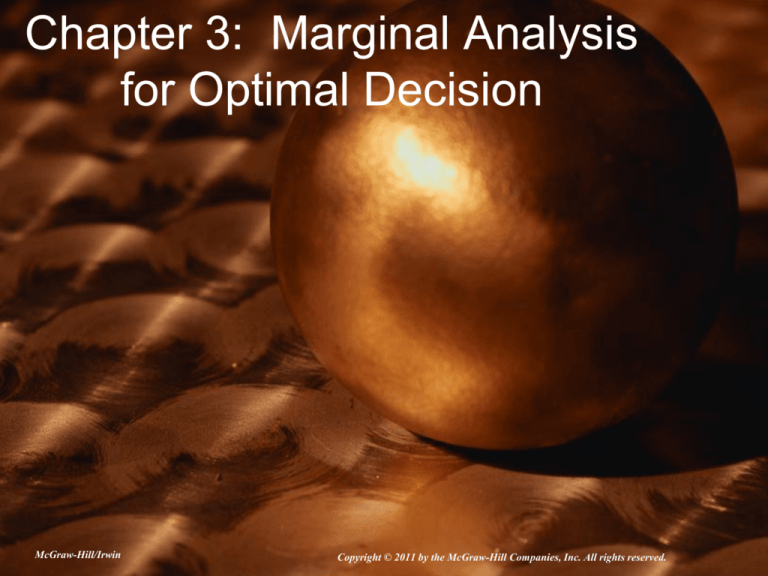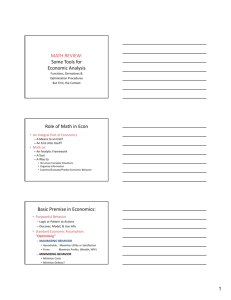
Chapter 3: Marginal Analysis
for Optimal Decision
McGraw-Hill/Irwin
Copyright © 2011 by the McGraw-Hill Companies, Inc. All rights reserved.
Optimization
• An optimization problem involves the
specification of three things:
• Objective function to be maximized or
minimized
• Activities or choice variables that determine
the value of the objective function
• Any constraints that may restrict the values of
the choice variables
3-2
Optimization
• Maximization problem
• An optimization problem that involves
maximizing the objective function
• Minimization problem
• An optimization problem that involves
minimizing the objective function
3-3
Optimization
• Unconstrained optimization
• An optimization problem in which the decision
maker can choose the level of activity from an
unrestricted set of values
Ex., profit maximization in the long-run
• Constrained optimization
• An optimization problem in which the decision
maker chooses values for the choice variables
from a restricted set of values
Ex., optimal combination of capital and labor given a
cost constraint
3-4
Choice Variables
• Choice variables determine the value of
the objective function
• Continuous variables
• Discrete variables
3-5
Choice Variables
• Continuous variables
• Can choose from uninterrupted span of
variables
• Discrete variables
• Must choose from a span of variables that is
interrupted by gaps
3-6
Net Benefit
• Net Benefit (NB)
• Difference between total benefit (TB) and total
cost (TC) for the activity
• NB = TB – TC
• Optimal level of the activity (A*) is the level
that maximizes net benefit
3-7
Marginal Benefit & Marginal Cost
• Marginal benefit (MB)
• Change in total benefit (TB) caused by an
incremental change in the level of the activity
• Marginal cost (MC)
• Change in total cost (TC) caused by an
incremental change in the level of the activity
3-8
NB( x ) B( x ) C ( x )
Maximize NB
dNB( x ) dB( x ) dC ( x )
0
dx
dx
dx
dB( x ) dC ( x )
dx
dx
dB( x )
marginal benefit
dx
dC ( x )
marginal cost
dx
At Max : MB MC
3-9
Optimal Level of Activity
(Figure 3.1)
Total benefit and total cost (dollars)
TC
4,000
•
F
D
•
•D’
3,000
B
•
2,310
G
•
TB
2,000
NB* = $1,225
C
•
1,085
1,000
• B’
•C’
0
200
A
350 = A*
600 700
1,000
Level of activity
Net benefit (dollars)
Panel A – Total benefit and total cost curves
M
1,225
1,000
•c’’
•
•
600
0
Panel B – Net benefit curve
d’’
200
350 = A*
600
f’’
A
•
Level of activity
1,000
NB
3-10
Relating Marginals to Totals
• Marginal variables measure rates of
change in corresponding total variables
• Marginal benefit & marginal cost are also
slopes of total benefit & total cost curves,
respectively
3-11
Relating Marginals to Totals
(Figure 3.2)
Total benefit and total cost (dollars)
TC
4,000
100
320
3,000
100
•B
520
100
•C
•
B’
1,000
C’
•
•
F
•
TB
820
100
2,000
640
•D
D’•
G
520
100
340
A
100
0
200
350 = A*
600
800
1,000
Level of activity
Panel A – Measuring slopes along TB and TC
Marginal benefit and
marginal cost (dollars)
MC (= slope of TC)
8
c (200, $6.40)
6
5.20
4
•
•d’ (600, $8.20)
b
•
•c’ (200, $3.40)
d (600, $3.20)
•
2
MB (= slope of TB)
0
•
1,000
g
200
350 = A*
Panel B – Marginals give slopes of totals
600
Level of activity
800
A
3-12
Using Marginal Analysis to Find
Optimal Activity Levels
• If marginal benefit > marginal cost
• Activity should be increased to reach highest net
benefit
• If marginal cost > marginal benefit
• Activity should be decreased to reach highest net
benefit
• Optimal level of activity
• When no further increases in net benefit are
possible
• Occurs when MB = MC
3-13
Using Marginal Analysis to Find A*
(Figure 3.3)
Net benefit (dollars)
MB = MC
MB > MC
100
300
•
c’’
MB < MC
M
•
100
•
d’’
500
A
0
200
350 = A*
600
800
1,000
NB
Level of activity
3-14
Optimization with Discrete
Choice
3-15
Unconstrained Maximization with
Discrete Choice Variables
• Increase activity if MB > MC
• Decrease activity if MB < MC
• Optimal level of activity
• Last level for which MB exceeds MC
3-16
Irrelevance of Sunk, Fixed, and
Average Costs
• Sunk costs
• Previously paid & cannot be recovered
• Fixed costs
• Constant & must be paid no matter the level of
activity
• Average (or unit) costs
• Computed by dividing total cost by the number of
units of the activity
3-17
Irrelevance of Sunk, Fixed, and
Average Costs
• These costs do not affect marginal cost & are
irrelevant for optimal decisions
3-18
Student Workbook
3-19
Student Workbook
3-20
Student Workbook
• Suppose there were fixed costs of $10 that
do not change with the level of activity, will
this affect your previous answers?
A
TB
0
1
2
3
4
5
0
10
19
25
30
34
TC MB MC NB
10
-10
12 10
2
-2
15
9
3
4
19
6
4
6
25
5
6
5
32
4
7
2
3-21
Student Workbook
3-22
Constrained Optimization
• Typical constrained maximization
problem
• Multiple beneficial activities
• Constraint on the total resources available.
The resources must be allocated efficiently
among the activities.
• Scarce resources must be allocated among
various activities so as to maximize total
benefit
3-23
Constrained Optimization
• The ratio MB/P represents the additional
benefit per additional dollar spent on the
activity
• Ratios of marginal benefits to prices of
various activities are used to allocate a
fixed number of dollars among activities
3-24
Constrained Optimization
• Expenditure on resources is optimally
allocated when the last dollar spend on
each activity provides identical marginal
benefits
MBA MBB
MBZ
...
PA
PB
PZ
Proof is in Appendix to Chapter 3
3-25
Maximize Sales
3-26
Steps in Decision Process
1. Calculate marginal benefit of additional
resources for all activities.
2. Calculate marginal benefit from last dollar
spent on resources devoted to each
activity.
3. Allocate each additional dollar of the
resource to the activity that provides the
greatest additional benefit
3-27
Ch. 3, Tech Problem 12
Total benefits of two activities.
The price of X is $2 per unit
The Price of Y is $10 per unit.
Level of activity
0
1
2
3
4
5
6
TB of X
0
30
54
72
84
92
98
TB of Y
0
100
190
270
340
400
450
BC of $24, Maximize Total Benefits
3-28
Ch. 3, Tech Problem 12
The price of X is $2 per unit
The Price of Y is $10 per unit.
Level of TB of X MB of MBx/Px TB of Y MB of Y MBy/Py
activity
X
0
0
0
1
30
30
15
100
100
10
2
54
24
12
190
90
9
3
72
18
9
270
80
8
4
84
12
6
340
70
7
5
92
8
4
400
60
6
6
98
6
3
450
50
5
Original budget restraint $26
Alternative budget constraint of $58
3-29
Homework, Prob. 1
TB
1. MB
A
TC
2. MC
A
3. NB TB TC
NB TB TC
4.
A
A
A
NB
5.
MB MC
A
3-30
• Find a
a is MB (2.5)
• Find b
b is MC
NB
MB MC
A
4.5 2.5 MC
MC 7
3-31









